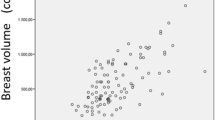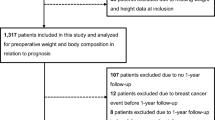Abstract
Purpose
Body mass index (BMI), waist-to-hip ratio (WHR), and tumor characteristics affect disease-free survival. Larger breast size may increase breast cancer risk, but its influence on disease-free survival is unclear. The purpose of this study was to elucidate whether breast size independently influenced disease-free survival in breast cancer patients.
Methods
Body measurements were obtained preoperatively from 772 breast cancer patients in a population-based ongoing cohort from southern Sweden. The research nurse measured breast volumes with plastic cups used by plastic surgeons doing breast reductions. Clinical data were obtained from patient charts and pathology reports.
Results
Patients with a BMI ≥ 25 kg/m2 had larger tumors (p < 0.001) and more axillary nodal involvement (p = 0.030). Patients with a WHR > 0.85 had larger tumors (p = 0.013), more advanced histological grade (p = 0.0016), and more axillary nodal involvement (p = 0.012). Patients with right + left breast volume ≥ 850 mL were more likely to have larger tumor sizes (p = 0.018), more advanced histological grade (p = 0.031), and more axillary nodal involvement (p = 0.025). There were 62 breast cancer events during the 7-year follow-up. Breast volume ≥ 850 mL was associated with shorter disease-free survival (p = 0.004) and distant metastasis-free survival (p = 0.001) in patients with estrogen receptor (ER)-positive tumors independent of other anthropometric measurements and age. In patients with ER-positive tumors, breast size was an independent predictor of shorter disease-free (HR 3.64; 95 % CI 1.42–9.35) and distant metastasis-free survival (HR 6.33; 95 %CI 1.36–29.43), adjusted for tumor characteristics, BMI, age, and treatment.
Conclusion
A simple and cheap anthropometric measurement with standardized tools may help identify a subgroup of patients in need of tailored breast cancer therapy.


Similar content being viewed by others
References
The National Board of Health and Welfare (2010) Cancer incidence in Sweden (Cited May 30, 2012) http://www.socialstyrelsen.se/Lists/Artikelkatalog/Attachments/18530/2011-12-15.pdf
Ferlay J, Shin HR, Bray F, Forman D, Mathers C, Parkin DM (2008) GLOBOCAN 2008 v1.2, Cancer incidence and mortality worldwide: IARC CancerBase No. 10 [Internet]. International Agency for Research on Cancer, Lyon
Han D, Nie J, Bonner MR et al (2006) Lifetime adult weight gain, central adiposity, and the risk of pre- and postmenopausal breast cancer in the Western New York exposures and breast cancer study. Int J Cancer 119:2931–2937
Carmichael AR (2006) Obesity and prognosis of breast cancer. Obes Rev 7:333–340
Carmichael AR, Bates T (2004) Obesity and breast cancer: a review of the literature. Breast 13:85–92
Loi S, Milne RL, Friedlander ML et al (2005) Obesity and outcomes in premenopausal and postmenopausal breast cancer. Cancer Epidemiol Biomarkers Prev 14:1686–1691
Protani M, Coory M, Martin JH (2010) Effect of obesity on survival of women with breast cancer: systematic review and meta-analysis. Breast Cancer Res Treat 123:627–635
Petrelli JM, Calle EE, Rodriguez C, Thun MJ (2002) Body mass index, height, and postmenopausal breast cancer mortality in a prospective cohort of US women. Cancer Causes Control 13:325–332
Enger SM, Ross RK, Paganini-Hill A, Carpenter CL, Bernstein L (2000) Body size, physical activity, and breast cancer hormone receptor status: results from two case-control studies. Cancer Epidemiol Biomarkers Prev 9:681–687
Suzuki R, Orsini N, Saji S, Key TJ, Wolk A (2009) Body weight and incidence of breast cancer defined by estrogen and progesterone receptor status—a meta-analysis. Int J Cancer 124:698–712
Pinheiro RL, Sarian LO, Pinto-Neto AM, Morais S, Costa-Paiva L (2009) Relationship between body mass index, waist circumference and waist to hip ratio and the steroid hormone receptor status in breast carcinoma of pre- and postmenopausal women. Breast 18:8–12
Healy LA, Ryan AM, Carroll P et al (2010) Metabolic syndrome, central obesity and insulin resistance are associated with adverse pathological features in postmenopausal breast cancer. Clin Oncol (R Coll Radiol) 22:281–288
Baumgartner KB, Hunt WC, Baumgartner RN et al (2004) Association of body composition and weight history with breast cancer prognostic markers: divergent pattern for Hispanic and non-Hispanic White women. Am J Epidemiol 160:1087–1097
Harvie M, Hooper L, Howell AH (2003) Central obesity and breast cancer risk: a systematic review. Obes Rev 4:157–173
Borugian MJ, Sheps SB, Kim-Sing C et al (2003) Waist-to-hip ratio and breast cancer mortality. Am J Epidemiol 158:963–968
Jernström H, Barrett-Connor E (1999) Obesity, weight change, fasting insulin, proinsulin, C-peptide, and insulin-like growth factor-1 levels in women with and without breast cancer: the Rancho Bernardo Study. J Womens Health Gend Based Med 8:1265–1272
Björntorp P (1997) Hormonal control of regional fat distribution. Hum Reprod 12(Suppl 1):21–25
Hollmann M, Runnebaum B, Gerhard I (1997) Impact of waist-hip-ratio and body-mass-index on hormonal and metabolic parameters in young, obese women. Int J Obes Relat Metab Disord 21:476–483
Goodwin PJ, Ennis M, Pritchard KI et al (2002) Fasting insulin and outcome in early-stage breast cancer: results of a prospective cohort study. J Clin Oncol 20:42–51
Bruning PF, Bonfrer JM, van Noord PA, Hart AA, de Jong-Bakker M, Nooijen WJ (1992) Insulin resistance and breast-cancer risk. Int J Cancer 52:511–516
Del Giudice ME, Fantus IG, Ezzat S, McKeown-Eyssen G, Page D, Goodwin PJ (1998) Insulin and related factors in premenopausal breast cancer risk. Breast Cancer Res Treat 47:111–120
Sellahewa C, Nightingale P, Carmichael AR (2008) Women with large breasts are at an increased risk of advanced breast cancer. Int Semin Surg Oncol 5:16
Hsieh CC, Trichopoulos D (1991) Breast size, handedness and breast cancer risk. Eur J Cancer 27:131–135
Hall HI, Coates RJ, Uhler RJ et al (1999) Stage of breast cancer in relation to body mass index and bra cup size. Int J Cancer 82:23–27
Ingram DM, Huang HY, Catchpole BN, Roberts A (1989) Do big breasts disadvantage women with breast cancer? Aust N Z J Surg 59:115–117
Hoe AL, Mullee MA, Royle GT, Guyer PB, Taylor I (1993) Breast size and prognosis in early breast cancer. Ann R Coll Surg Engl 75:18–22
Sung J, Song YM, Stone J, Lee K, Kim SY (2010) Association of body size measurements and mammographic density in Korean women: the Healthy Twin study. Cancer Epidemiol Biomarkers Prev 19:1523–1531
Wade TD, Zhu G, Martin NG (2010) Body mass index and breast size in women: same or different genes? Twin Res Hum Genet 13:450–454
Jernström H, Olsson H (1997) Breast size in relation to endogenous hormone levels, body constitution, and oral contraceptive use in healthy nulligravid women aged 19–25 years. Am J Epidemiol 145:571–580
Ray JG, Mohllajee AP, van Dam RM, Michels KB (2008) Breast size and risk of type 2 diabetes mellitus. CMAJ 178:289–295
Schrauder MG, Fasching PA, Haberle L et al (2011) Diabetes and prognosis in a breast cancer cohort. J Cancer Res Clin Oncol 137:975–983
Kusano AS, Trichopoulos D, Terry KL, Chen WY, Willett WC, Michels KB (2006) A prospective study of breast size and premenopausal breast cancer incidence. Int J Cancer 118:2031–2034
Ringberg A, Bågeman E, Rose C, Ingvar C, Jernström H (2006) Of cup and bra size: reply to a prospective study of breast size and premenopausal breast cancer incidence. Int J Cancer 119: 2242–2243; Author reply 4
Strombeck JO, Malm M (1986) Priority grouping in a waiting list of patients for reduction mammaplasty. Ann Plast Surg 17:498–502
(2000) Obesity: preventing and managing the global epidemic. Report of a WHO consultation. World Health Organization technical report series. 894:i–xii, 1–253
Bågeman E, Ingvar C, Rose C, Jernström H (2008) Coffee consumption and CYP1A2*1F genotype modify age at breast cancer diagnosis and estrogen receptor status. Cancer Epidemiol Biomarkers Prev 17:895–901
Jernström H, Sandberg T, Bågeman E, Borg Å, Olsson H (2005) Insulin-like growth factor-1 (IGF1) genotype predicts breast volume after pregnancy and hormonal contraception and is associated with circulating IGF-1 levels: implications for risk of early-onset breast cancer in young women from hereditary breast cancer families. Br J Cancer 92:857–866
Pollak M (2008) Insulin and insulin-like growth factor signalling in neoplasia. Nat Rev Cancer 8:915–928
Hankinson SE, Willett WC, Colditz GA et al (1998) Circulating concentrations of insulin-like growth factor-I and risk of breast cancer. Lancet 351:1393–1396
Gee JM, Robertson JF, Gutteridge E et al (2005) Epidermal growth factor receptor/HER2/insulin-like growth factor receptor signalling and oestrogen receptor activity in clinical breast cancer. Endocr Relat Cancer 12(Suppl 1):S99–S111
Key TJ, Appleby PN, Reeves GK, Roddam AW (2010) Insulin-like growth factor 1 (IGF1), IGF binding protein 3 (IGFBP3), and breast cancer risk: pooled individual data analysis of 17 prospective studies. Lancet Oncol 11:530–542
Hartmann BW, Laml T, Kirchengast S, Albrecht AE, Huber JC (1998) Hormonal breast augmentation: prognostic relevance of insulin-like growth factor-I. Gynecol Endocrinol 12:123–127
Diorio C, Pollak M, Byrne C et al (2005) Insulin-like growth factor-I, IGF-binding protein-3, and mammographic breast density. Cancer Epidemiol Biomarkers Prev 14:1065–1073
Chiu SY, Duffy S, Yen AM, Tabar L, Smith RA, Chen HH (2010) Effect of baseline breast density on breast cancer incidence, stage, mortality, and screening parameters: 25-year follow-up of a Swedish mammographic screening. Cancer Epidemiol Biomarkers Prev 19:1219–1228
Heidegger I, Pircher A, Klocker H, Massoner P (2011) Targeting the insulin-like growth factor network in cancer therapy. Cancer Biol Ther 11:701–707
Mayes JS, Watson GH (2004) Direct effects of sex steroid hormones on adipose tissues and obesity. Obes Rev 5:197–216
Lundin KB, Henningson M, Hietala M, Ingvar C, Rose C, Jernström H (2011) Androgen receptor genotypes predict response to endocrine treatment in breast cancer patients. Br J Cancer 105:1676–1683
van Anders SM, Hampson E (2005) Waist-to-hip ratio is positively associated with bioavailable testosterone but negatively associated with sexual desire in healthy premenopausal women. Psychosom Med 67:246–250
Peiris AN, Struve MF, Kissebah AH (1987) Relationship of body fat distribution to the metabolic clearance of insulin in premenopausal women. Int J Obes 11:581–589
Subbaramaiah K, Howe LR, Bhardwaj P et al (2011) Obesity is associated with inflammation and elevated aromatase expression in the mouse mammary gland. Cancer Prev Res 4:329–346
Goodwin PJ, Stambolic V, Lemieux J et al (2011) Evaluation of metformin in early breast cancer: a modification of the traditional paradigm for clinical testing of anti-cancer agents. Breast Cancer Res Treat 126:215–220
Acknowledgments
This study was supported by grants from the Swedish Cancer Society, the Swedish Research Council, the Medical Faculty at Lund University, the Mrs. Berta Kamprad’s Foundation, the Gunnar Nilsson Foundation, the Crafoord Foundation, the Konung Gustaf V Jubileumsfond (104152), the South Swedish Health Care Region (Region Skåne ALF), Swedish Breast Cancer Group (BRO), and the Lund Hospital Fund. We thank our research nurses Linda Ågren, Anette Möller, Karin Henriksson, Anna Weddig, and Maj-Britt Hedenblad. We thank Dr Eric Dryver for proofreading the manuscript.
Conflict of interest
The authors declare that they have no conflict of interest.
Author information
Authors and Affiliations
Corresponding author
Rights and permissions
About this article
Cite this article
Markkula, A., Bromée, A., Henningson, M. et al. Given breast cancer, does breast size matter? Data from a prospective breast cancer cohort. Cancer Causes Control 23, 1307–1316 (2012). https://doi.org/10.1007/s10552-012-0008-9
Received:
Accepted:
Published:
Issue Date:
DOI: https://doi.org/10.1007/s10552-012-0008-9




